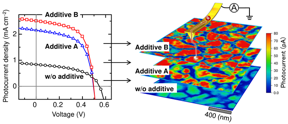Home > Press > Shedding light on polymer solar cells: Illuminating how solvent additives improve efficiency:Researchers from Nara Institute of Science and Technology use photoconductive atomic force microscopy to investigate the role of solvent additives in the performance of all-polymer blend
 |
| Improvements in the device performance by addition of a solvent additive A and B (left). Photocurrent flowing in the polymer solar cells, which is visualized at nanometer scale by PC-AFM (right).
CREDIT Hiroaki Benten |
Abstract:
All-polymer blend solar cells are expected to play an important role in the transition to clean energy technologies because they can be easily produced in large-scale flexible sheets. However, their performance has lagged behind that of more traditional silicon alternatives, as well as other organic solar cells.
Shedding light on polymer solar cells: Illuminating how solvent additives improve efficiency:Researchers from Nara Institute of Science and Technology use photoconductive atomic force microscopy to investigate the role of solvent additives in the performance of all-polymer blend
Ikoma, Japan | Posted on January 28th, 2022
All-polymer blend solar cells are formed by combining two polymer solutions that solidify into a film on an electrode with in the form of interpenetrating networks, a kind of phase-separation. The introduction of solvent additives to the polymer solution has been shown to increase the efficiency of all-polymer blend solar cells. However, the exact process underlying this improvement has not been fully understood. Now, in a study recently published in ACS Applied Polymer Materials, researchers from Nara Institute of Science and Technology have investigated the performance enhancement mechanism using photoconductive atomic force microscopy (PC-AFM). Their findings are expected to help accelerate the widespread application of polymer-based solar cells.
“The empirical nature of solvent additive-mediated efficiency enhancement has hindered the optimization of all-polymer blend solar cell performance, so there has been an urgent need for a greater understanding of the process,” explains senior author Hiroaki Benten. “To that end, we used PC-AFM to interrogate the nanoarchitecture that underpins the performance enhancement.”
PC-AFM is an advanced microscopy technique that allows photocurrents to be visualized with nanometer-scale resolution. The researchers found that trace solvent additives improved the power conversion and photocurrent density of an all-polymer blend solar cell by a factor of up to ~3 by enhancing the ordering and crystallization of the polymer microstructure in the solar cell without damaging the phase-separated structure.
Absorption spectroscopy measurements further confirmed that the trace additives improved the ordering in the polymer microstructures. By forming a network that efficiently transports the photogenerated charges to the external electrode, the flow of photocurrent is increased.
We found that local photocurrents were enhanced, somewhat like forming a new charge current highway, while the scale of phase separation that is critical to device functionality was retained,” says coauthor Masakazu Nakamura. “We believe that this insight will be broadly applicable to all-polymer blend solar cells, not just those based on our choice of polymers.”
The results of the study are expected to be important for optimizing the performance of all-polymer blend solar cells. By using the findings to minimize laboratory trial-and-error, it is hoped researchers can speed up ongoing bench-to-market efforts, taking us a step closer to high-performance solar cells that are environmentally sustainable and easy to produce on a large scale.
####
For more information, please click here
Contacts:
Takahito Shikano
Nara Institute of Science and Technology
Copyright © Nara Institute of Science and Technology
If you have a comment, please Contact us.
Issuers of news releases, not 7th Wave, Inc. or Nanotechnology Now, are solely responsible for the accuracy of the content.
News and information
![]()
Scientists enhance energy storage capacity of graphene supercapacitors via solar heating January 28th, 2022
![]()
HKUST co-led study reveals topology at the corner of the dining table January 28th, 2022
![]()
Shining a light on synthetic dimensions January 28th, 2022
Possible Futures
![]()
Scientists enhance energy storage capacity of graphene supercapacitors via solar heating January 28th, 2022
![]()
Void-confinement effect of nanoreactor promotes heterogeneous catalysis January 28th, 2022
![]()
Shining a light on synthetic dimensions January 28th, 2022
Discoveries
![]()
Scientists enhance energy storage capacity of graphene supercapacitors via solar heating January 28th, 2022
![]()
Void-confinement effect of nanoreactor promotes heterogeneous catalysis January 28th, 2022
![]()
2D materials could be used to simulate brain synapses in computers January 28th, 2022
![]()
Shining a light on synthetic dimensions January 28th, 2022
Announcements
![]()
New approach transports trapped ions to create entangling gates January 28th, 2022
![]()
Acceleration of cancer biomarker detection for point of care diagnostics January 28th, 2022
![]()
HKUST co-led study reveals topology at the corner of the dining table January 28th, 2022
Interviews/Book Reviews/Essays/Reports/Podcasts/Journals/White papers/Posters
![]()
New approach transports trapped ions to create entangling gates January 28th, 2022
![]()
Acceleration of cancer biomarker detection for point of care diagnostics January 28th, 2022
![]()
HKUST co-led study reveals topology at the corner of the dining table January 28th, 2022
Energy
![]()
Photon recycling The key to high-efficiency perovskite solar cells January 14th, 2022
![]()
Templating approach stabilizes ideal material for alternative solar cells December 24th, 2021
![]()
Activating lattice oxygen in perovskite oxide to optimize fuel cell performance December 17th, 2021
![]()
Nanodiamonds are key to efficient hydrogen purification: Nanodiamonds may be tiny, but they can help with one of the biggest problems facing humanity today: Climate change December 17th, 2021
Solar/Photovoltaic
![]()
Scientists enhance energy storage capacity of graphene supercapacitors via solar heating January 28th, 2022
![]()
Photon recycling The key to high-efficiency perovskite solar cells January 14th, 2022
![]()
Templating approach stabilizes ideal material for alternative solar cells December 24th, 2021
![]()
Reaction-dependent coffee-ring-regulating method in spray-coating perovskite November 5th, 2021










